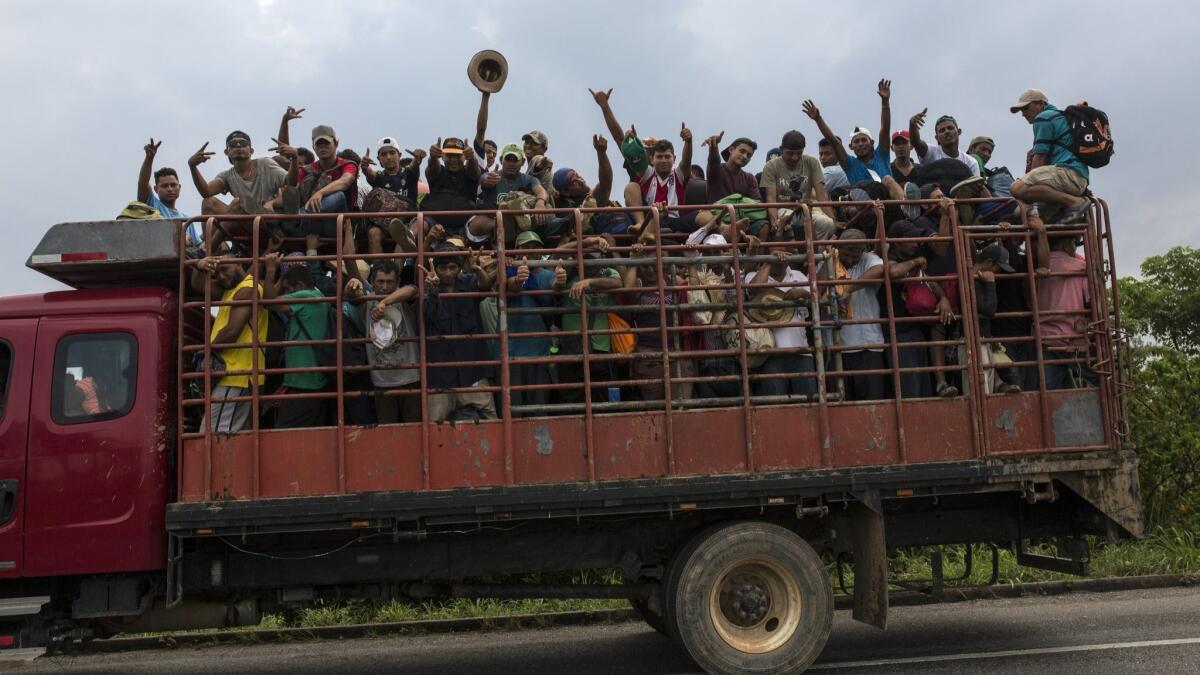Migrant caravan continues north after Mexican governor abruptly pulls offer of buses

- Share via
Reporting from Mexico City — The U.S.-bound migrant caravan that has prompted President Trump to deploy thousands of troops along the southern border and has become a contentious issue in the U.S. midterm election was headed north again on Saturday, traversing the Mexican gulf state of Veracruz — as hopes faded for buses to transport the exhausted multitudes.
The faltering spirits and eroding health of caravan participants — who have been on the road for more than two weeks since leaving Honduras — were briefly buoyed late Friday when the governor of Veracruz, Miguel Angel Yunes, announced that he would provide scores of buses to carry them to Mexico City.
Footage showed caravan members celebrating news about the prospective bus transport from their latest encampment in the town of Sayula de Aleman, in Veracruz state, 350 miles southeast of Mexico City.
The plan was for caravan members to rest, recuperate and receive much-needed medical attention in the Mexican capital while representatives sought to meet with government officials.
But then Yunes abruptly rescinded his offer, declaring that “it wouldn’t be correct” to take the assemblage to Mexico City at a time when the capital was experiencing severe water shortages. Ongoing maintenance work has left much of the capital and environs without running water through this weekend.
Instead, the governor offered buses to take the migrants to a site farther south in Veracruz state, a proposal that was rejected.
“The arrival to Mexico City is crucial,” caravan representatives said in a statement circulated on social media. “At the moment the exodus includes dozens of sick children, pregnant women and various participants with illnesses and wounds.”
The migrants, mostly Hondurans, renewed their trek early Saturday from Sayula de Aleman with the intention of making it to the town of Isla, about 45 miles to the north. That is still more than 700 miles from the nearest point along the U.S.-Mexico border.
It was not clear if the travelers would veer off to Mexico City or pursue a more direct route to the border.
Estimates have put the current number of caravan participants at between 3,000 and 5,000, though there is no precise figure or demographic breakdown. Most appear to be young men, but there are many women and children among them.
The caravan has covered more than 800 miles — including more than 400 miles in Mexico — since setting out from San Pedro Sula in Honduras on Oct. 13. They have endured sweltering temperatures and tropical downpours.
At least one woman has given birth. Others are suffering from the effects of fatigue and assorted ailments, including colds, blistered feet, dehydration and insect bites.
Both Veracruz and neighboring Tamaulipas state — which forms part of Mexico’s long border with Texas — have been notoriously hazardous terrain for Central American migrants, who have long proceeded overland in small groups through Mexico en route to the United States. Organized gangs regularly prey on the migrants, subjecting them to extortion, sexual violence and other abuse.
Tamaulipas has been the site of several massacres of Central American migrants, costing the lives of hundreds.
But caravan travelers voice the hope that their numbers and the intense publicity surrounding their voyage will continue to provide a measure of security. A large contingent of journalists is accompanying the exodus, along with human rights advocates, medical volunteers and others. Mexican police also track the caravan’s progress, but have not blocked its advance, though most if not all caravan trekkers lack Mexican immigration papers.
While on the road, the ragtag caravan stretches out for miles along the highway. Many manage to get rides from trucks and cars, often crowding dangerously into flatbed trailers or pickup trucks.
But others walk much of the way. The group generally rests at nights in towns along the route. Residents of those mostly poor towns have provided food, water and some semblance of shelter, if available. Travelers have slept in churches, homes, public halls, in fields and in central plazas and on the streets.
At least one caravan member, a young Honduran man, was killed when he fell from a truck and was run over last month in Mexico’s southern Chiapas state.
Caravan participants say they are fleeing poverty and violence in their home countries. Many, if not most, are expected to seek political asylum if they reach the U.S.-Mexico border.
At least two other smaller groups of Central Americans are following in the wake of the main caravan. The two groups, reportedly numbering some 3,000 people in total, on Saturday were making their way north through Chiapas.
Some 3,000 Central Americans who were part of the recent wave of caravans have opted to take advantage of Mexico’s offer of temporary residency and jobs, if they agree to remain in southern Mexico, according to Mexican authorities. Mexican officials are hopeful that more will accept the offer or opt voluntarily to return home, as many have already done, before nearing the border zone. But thousands have opted to push onward to the north.
In the run-up to next week’s midterm elections, Trump has labeled the caravan an “invasion” and a threat to U.S. security, vowing that the migrants would not enter the United States. The president has ordered a military deployment along the border and said tent cities would be erected if needed.
Staff writer Kate Linthicum in Mexico City and Cecilia Sanchez of The Times’ Mexico City bureau contributed to this report.
Twitter: @PmcdonnellLAT
More to Read
Sign up for Essential California
The most important California stories and recommendations in your inbox every morning.
You may occasionally receive promotional content from the Los Angeles Times.












